Want to build a comfortable and affordable home for your chickens? You’re in the perfect spot! Discover 19 easy DIY chicken coop ideas. These projects will guide you in creating a practical and delightful space for your flock. Building a coop can be simple and enjoyable!
Adding Nesting Boxes for Egg Laying
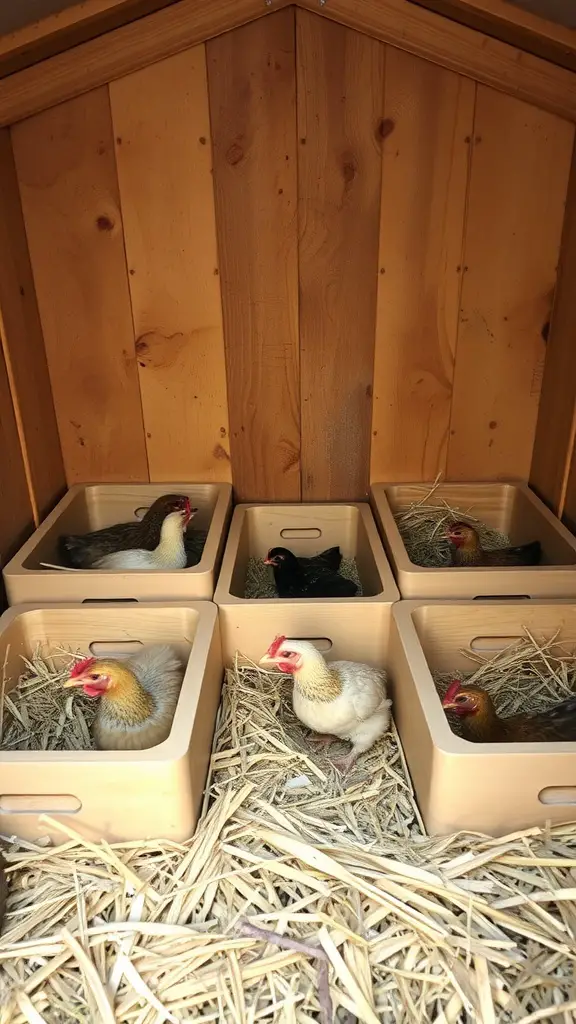
Nesting boxes are key for a productive chicken coop, particularly for hens laying eggs. These comfortable, private spots encourage chickens to lay. The image showcases well-built nesting boxes, offering each hen a perfect, cozy space.
Easy-to-use containers, similar to those pictured, simplify nesting box setup. Ensure they are clean and stocked with fresh straw or hay. This keeps the boxes comfortable and aids in maintaining clean eggs.
Position nesting boxes at a comfortable height for your hens. Each box should accommodate a single hen. Ensure you have enough boxes to prevent overcrowding. A good rule of thumb is one box for every three to four hens.
Inspect nesting boxes frequently. Collect eggs and keep them clean. Happy hens mean fresh eggs for you!
Creating Ventilation for Fresh Air
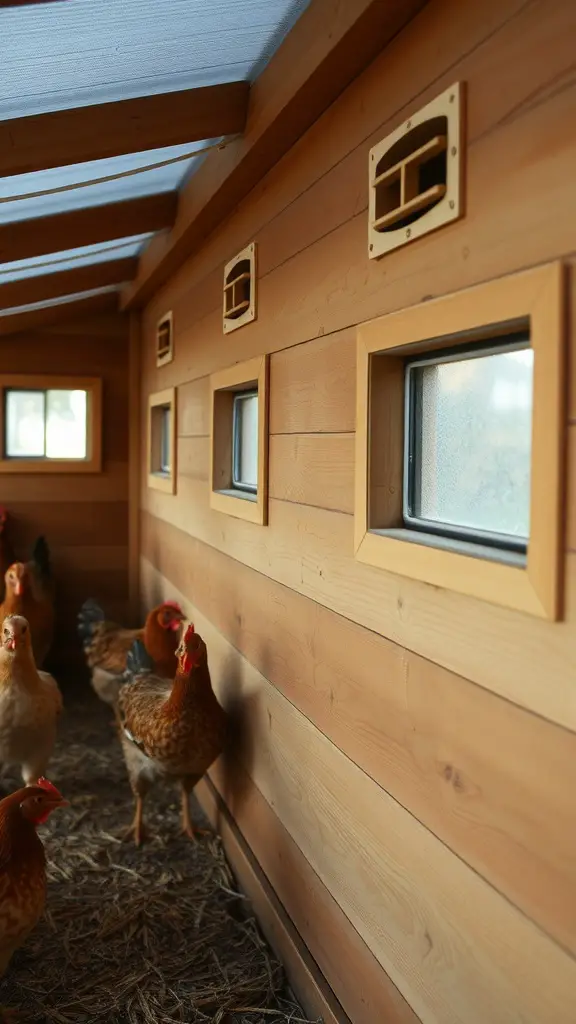
Proper coop ventilation is essential for healthy chickens. It controls humidity and ensures fresh air, directly impacting their well-being.
This coop boasts excellent ventilation through multiple openings. These vents ensure fresh airflow, protecting your chickens from harmful drafts.
Think about adding adjustable vents to your coop. These let you manage airflow based on the season. Maximize ventilation during hot weather to keep your chickens comfortable. Reduce airflow in colder months to help them stay warm.
Install vents near the coop’s ceiling. Hot air naturally ascends, so this placement effectively vents heat. This ensures a more comfortable and healthy space for your chickens.
Don’t forget routine vent checks. Clean vents guarantee peak airflow and stop obstructions.
Essential Materials for Building a Chicken Coop

Building your own chicken coop? Gathering the correct supplies is essential. This image showcases various tools and materials vital for your coop construction project in 2025.
Initially, you’ll see wooden planks and dowels. These components create the coop’s core structure. Opting for high-quality wood guarantees long-lasting protection for your chickens against weather conditions.
You’ll also need key tools such as a hammer and clamps. These will be invaluable during coop assembly. Quality tools streamline the building process and make it more satisfying.
Screws and nails are essential for a secure coop. A robust structure is vital, particularly in areas prone to high winds or predators.
Finally, remember the mesh or wire. It’s crucial for good airflow and chicken safety. Choose the correct gauge to keep predators out.
Choosing the Right Location for Your Chicken Coop

Choosing the right spot for your chicken coop is crucial. Observe the red coop in the picture, perfectly situated in a tidy backyard. This location offers a good mix of sun and shade, vital for healthy chickens.
Firstly, think about sunlight. Chickens thrive with some sun exposure daily. However, they also require shaded spots to escape the heat. The big tree provides ideal shade, ensuring a pleasant space for the chickens.
Consider accessibility next. Aim for effortless coop access for daily tasks like feeding and cleaning. The design shown prioritizes easy access while ensuring chicken safety. Also, confirm the absence of disturbances, such as busy roads, that could stress your flock.
Also, monitor the drainage carefully. Chickens prefer dry areas, avoiding mud. This well-maintained lawn indicates excellent drainage, making it a perfect location for them.
Finally, think about how close the coop is to your house. A nearby coop simplifies daily tasks and keeps your hens safe. Careful planning lets you create a great chicken space, similar to the beautiful one shown here!
Designing a Functional Coop Layout

In 2025, smart chicken coop design prioritizes efficient space utilization. This image showcases a streamlined layout, optimizing both chicken movement and overall cleanliness. It offers chickens plenty of room to move around while maintaining a well-organized environment.
Our coop’s layout features specific zones for nesting, feeding, and ample roaming. This setup prioritizes your chickens’ comfort and well-being. Notice the well-defined walkways? They provide effortless access to all areas of the coop.
Improve your coop’s atmosphere with good airflow and sunlight. This design shows a great balance of these needs, ensuring your chickens are safe and comfortable. A smart layout simplifies daily tasks, letting you better enjoy caring for your flock.
Planning your DIY chicken coop? Consider how your flock will use the space. A well-designed coop boosts their health and your enjoyment of raising chickens. Smart planning is key to success!
Installing Durable Flooring
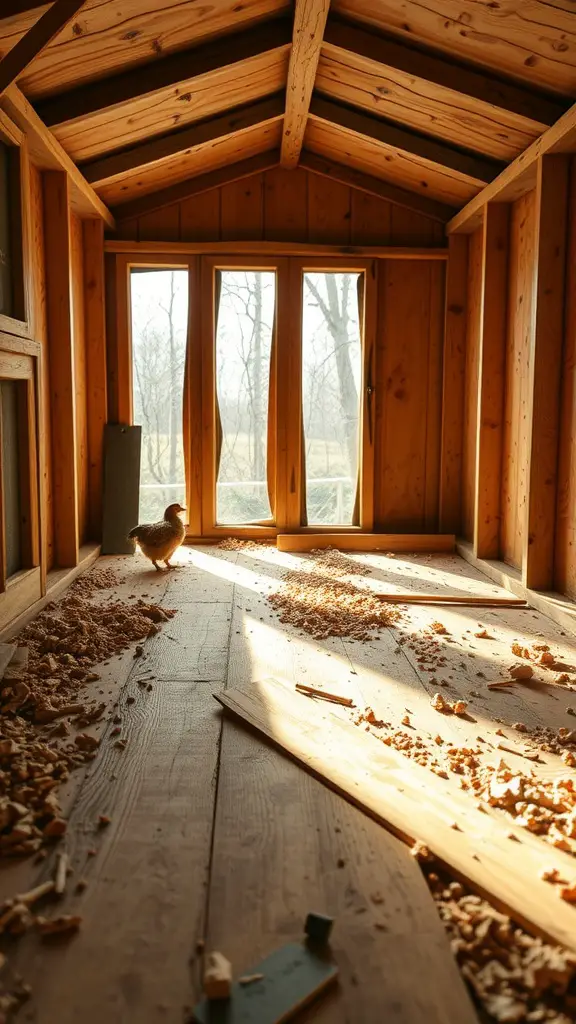
Constructing a chicken coop? Prioritize the flooring! This image showcases a charming coop featuring wooden beams and natural sunlight. The floor is currently being built, with boards in place and wood shavings spread about. Remember, a durable floor is key to your chickens’ well-being and comfort.
Selecting the appropriate material is key for your chicken coop. Treated plywood or concrete are excellent choices. They offer easy cleaning and resist moisture effectively. A robust floor stops mud and water from entering, keeping your chickens dry and healthy. Enhance their comfort and waste control by adding a layer of straw or wood shavings.
This image showcases the initial stages of a wooden floor, destined to be ideal for your chickens. Ensure each board is firmly secured. Chickens are inquisitive and may peck at any unsecured edges. A properly installed floor enhances the coop’s appearance and guarantees a secure space for your flock in 2025.
If your coop is outside, drainage is key. A slightly sloped floor directing water away will maintain cleanliness. Thoughtful flooring choices significantly improve your coop’s upkeep!
Building the Coop Frame

Constructing your chicken coop’s frame marks a significant milestone in your DIY journey. This image showcases a robust frame featuring upright wooden supports and a durable roof. The open layout promotes ample ventilation, crucial for maintaining your chickens’ well-being in 2025.
The frame utilizes unfinished wood, a cost-effective and bird-safe option. Precise measurements and cuts are crucial for a snug fit. Eliminate gaps to keep predators out!
A grid sits at the coop’s heart, directly on the ground. It likely serves as a foundation for coop flooring or a designated run space. This grid design aids in maintaining cleanliness and facilitates drainage. Selecting the right flooring is crucial. It helps prevent pests and ensures a hygienic environment for your chickens.
Building your chicken coop frame is manageable. Follow each step carefully, and you’ll quickly create a comfortable space for your chickens.
Constructing Roosting Perches for Comfort
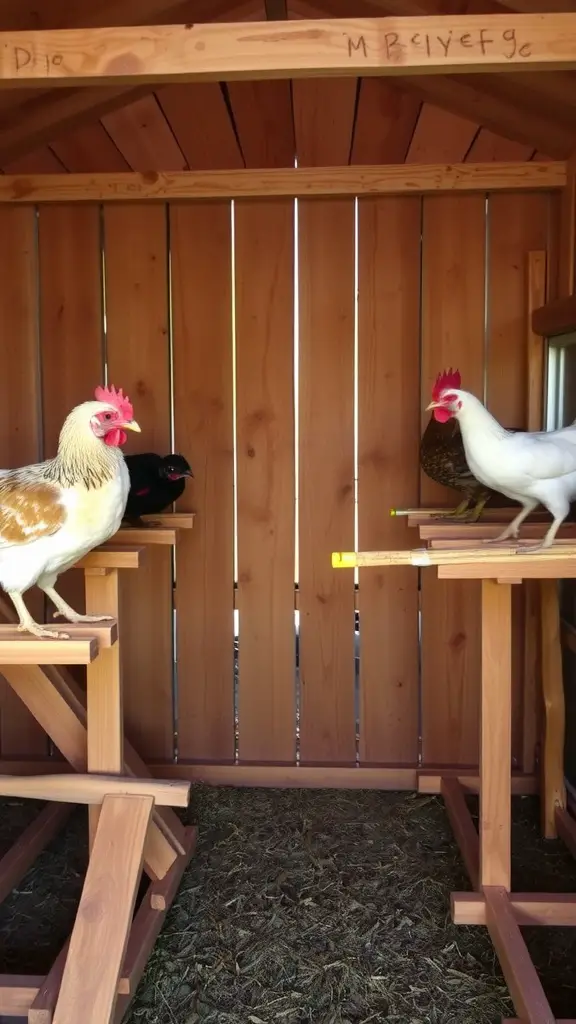
Roosting perches are a must-have in any chicken coop. They offer your chickens a comfortable place to sleep at night. This image displays strong, well-designed perches, perfect for chickens to relax. Crafted from durable wood, these perches are spaced correctly. This ensures each bird has ample space.
Consider height and width when constructing roosting perches. Chickens typically like higher roosts. Position perches at a comfortable height for them to reach. The perch width should allow them to fully grip it for security, without being excessively wide.
Notice the slight slant of the perches in the picture. This angled design stops chickens from slipping at night. Smooth, splinter-free wood adds to their comfort. It’s a simple upgrade that greatly improves their living space.
Ensure ample space between roosting bars to minimize conflicts. Chickens establish a pecking order, and sufficient room promotes flock harmony. A comfortable roosting setup contributes significantly to their overall health and contentment.
Implementing a Feeding System
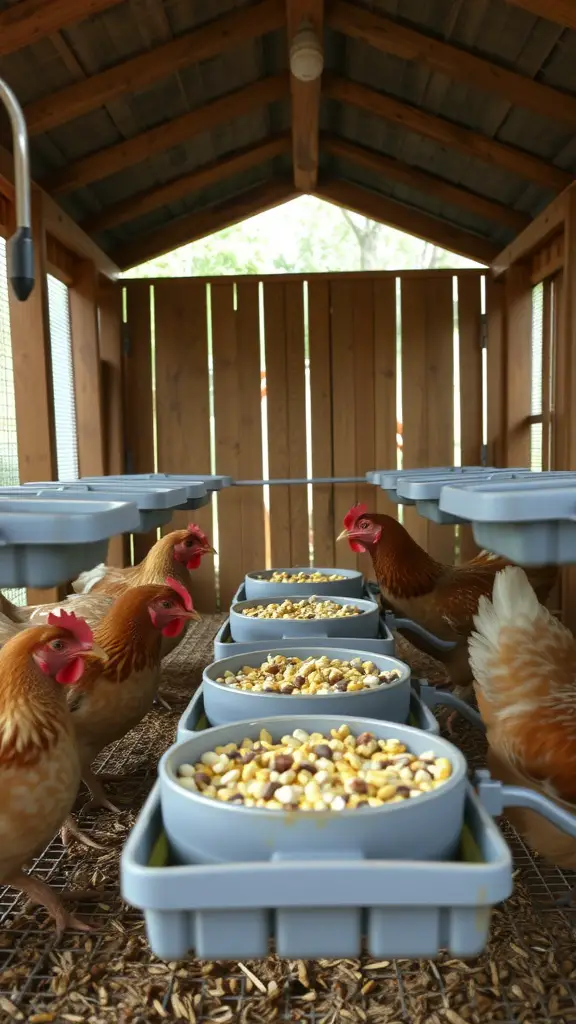
A well-designed feeding setup is crucial for healthy, happy chickens. The image showcases multiple feeding bowls filled with a grain mix, vital for their nutrition. These bowls are carefully positioned, allowing easy access for your flock to eat comfortably.
Optimize your chicken feeding setup with elevated feeders, as pictured. These feeders minimize feed waste and maintain cleanliness. This design also deters pests from accessing the food. Regularly inspect and refill the bowls, ensuring they are clean. This practice keeps your chickens eager for feeding time.
Offering a diverse grain mix ensures your chickens receive a well-rounded diet. Consider incorporating corn, oats, and protein-rich pellets. Each component contributes uniquely to their overall health. A little variety significantly boosts their well-being. Consequently, your chickens will be healthier and more productive in 2025!
Creating an Outdoor Run for Chickens

Creating an outdoor chicken run is both enjoyable and beneficial for your flock. The picture showcases happy chickens in their expansive enclosure. They have ample space to forage and explore on the grassy ground. Comfortable shelters are also provided, offering respite from the elements.
Think about size and materials when designing your chicken run. Aim for a minimum of 10 square feet per chicken. This gives them ample room to flourish. Strong fencing is crucial for protecting them from predators.
The image highlights the enclosure’s secure fencing. Its height prevents unwanted animal intrusions. A roof offers extra protection from birds of prey. Enhance the space with perches, dust bathing areas, and shaded spots under trees for an enriching environment.
An engaging outdoor space is key to happy and active chickens. Observing their natural behaviors as they explore and interact is a joy. A thoughtfully planned run is essential for a thriving chicken coop in 2025!
Using Waterproof Roofing Materials
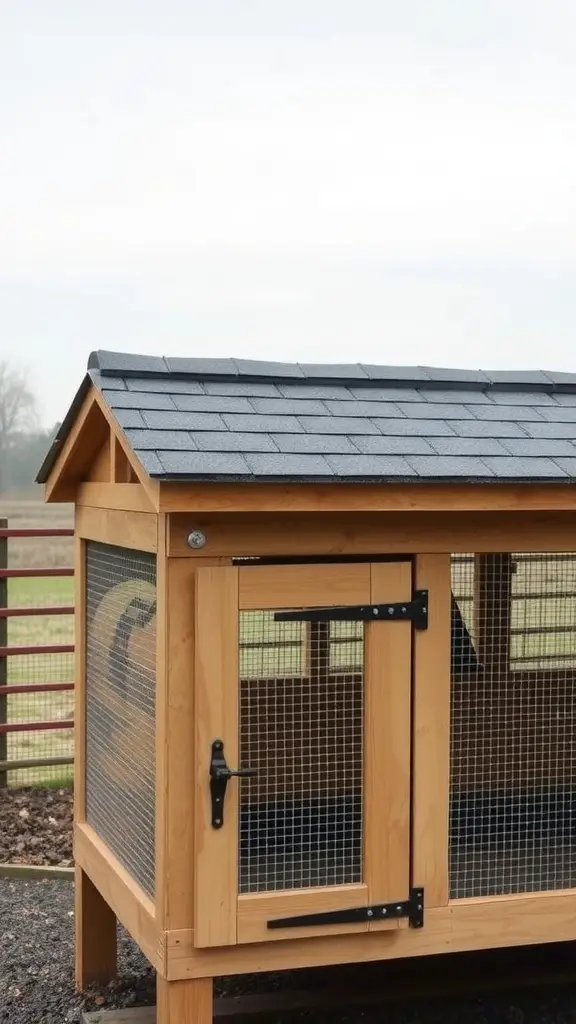
Selecting the ideal roofing for your chicken coop is crucial. A weatherproof roof ensures your chickens stay dry and comfortable, particularly when it rains.
This image showcases a sturdy chicken coop featuring a slanted roof. Dark shingles cover the roof, offering both an appealing aesthetic and superior weather resistance.
Opting for durable materials such as asphalt shingles or metal roofing guarantees a watertight structure. This proactive measure prevents water damage, minimizing future repair costs and extending the lifespan of your chicken coop.
Also, think about adding a small overhang. This will guide rainwater away from the coop’s sides. This keeps it drier and boosts its lifespan.
Ventilation is key! Ensure your 2025 roof design prioritizes proper airflow. This prevents moisture buildup without sacrificing essential waterproofing.
Installing a Chicken Door for Easy Access
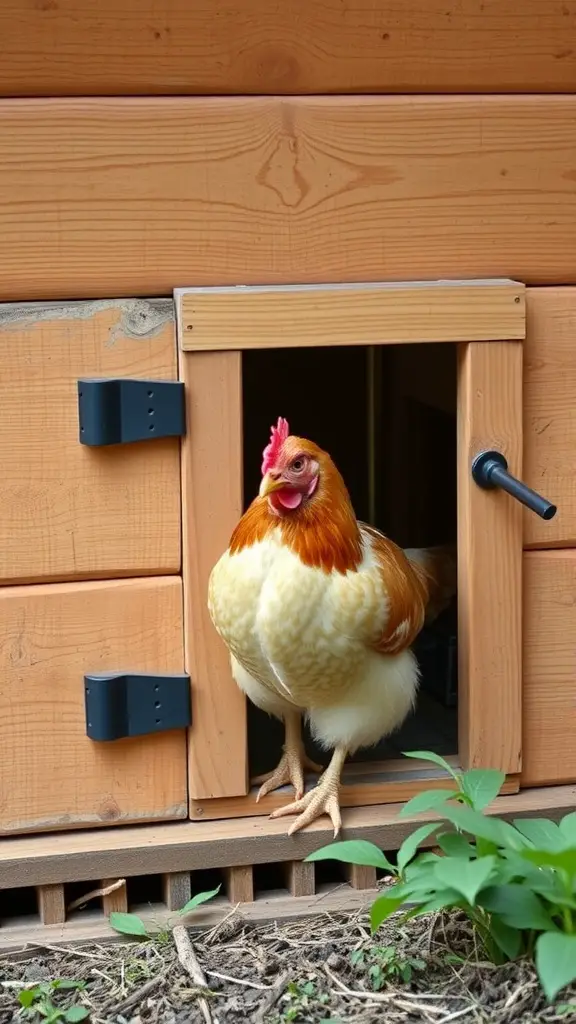
Imagine a snug chicken coop featuring a perfectly sized door for your flock. This is where a chicken door shines. It grants chickens the freedom to move in and out as they please, simplifying their daily routines. A thoughtfully crafted chicken door is a straightforward, yet valuable, enhancement to any DIY chicken coop endeavor.
The photo showcases a chicken curiously looking out from a miniature door. This clever design provides chickens with effortless outdoor access. It also enhances the coop’s aesthetic appeal. Constructing this door involves readily available materials. Installation is surprisingly straightforward, despite initial impressions.
Design your chicken door with size and location in mind. Ensure it’s adequately sized for easy chicken passage. A secure latch is crucial for nighttime safety. This provides assurance knowing your chickens are protected.
Adding a chicken door to your coop is a great idea. It lets your chickens roam outside, boosting their well-being. It also simplifies feeding and care.
Securing the Coop from Predators

Protecting your chickens from predators is crucial when designing a coop. The photo showcases a secure coop featuring robust wire mesh. This design effectively prevents predators from entering, while allowing your chickens to safely roam outside.
Wire mesh creates a strong barrier against most animals. Select a durable, rust-resistant material to handle weather conditions. Consider covering the top for added protection against jumping or flying predators. The coop in the picture includes a covered roof, a wise safety measure.
Also, examine the area surrounding your chicken coop. Predators such as raccoons and foxes might try to dig under the walls. To stop them, bury wire mesh about 12 inches deep around the coop’s edge. This simple measure offers added security and protects your chickens.
Always secure your chicken coop! Use strong locks on all doors and windows. The coop pictured has a door lock, a simple but effective safety feature. Check these areas often to keep your chickens safe, both day and night.
Providing Fresh Water Sources
Providing fresh water is essential for healthy chickens. This image showcases an organized watering system for your flock. Multiple water containers are neatly arranged, guaranteeing ample hydration all day long. These containers are designed for optimal water storage.
Ensure your chickens always have fresh, clean water, particularly during hot weather. The elevated water containers shown help maintain water purity by preventing dirt and debris contamination. This user-friendly design simplifies refilling and upkeep.
Opt for sizable, robust water containers. This reduces how often you need to refill them. If you have many chickens, provide several water sources. This prevents overcrowding. Fresh water is vital. Change it regularly to keep your chickens healthy.
Beyond using containers, consider a water heater during winter. This prevents freezing, guaranteeing your chickens always have access to water. These methods simplify providing essential hydration for healthy, thriving chickens.
Incorporating a Cleanout System
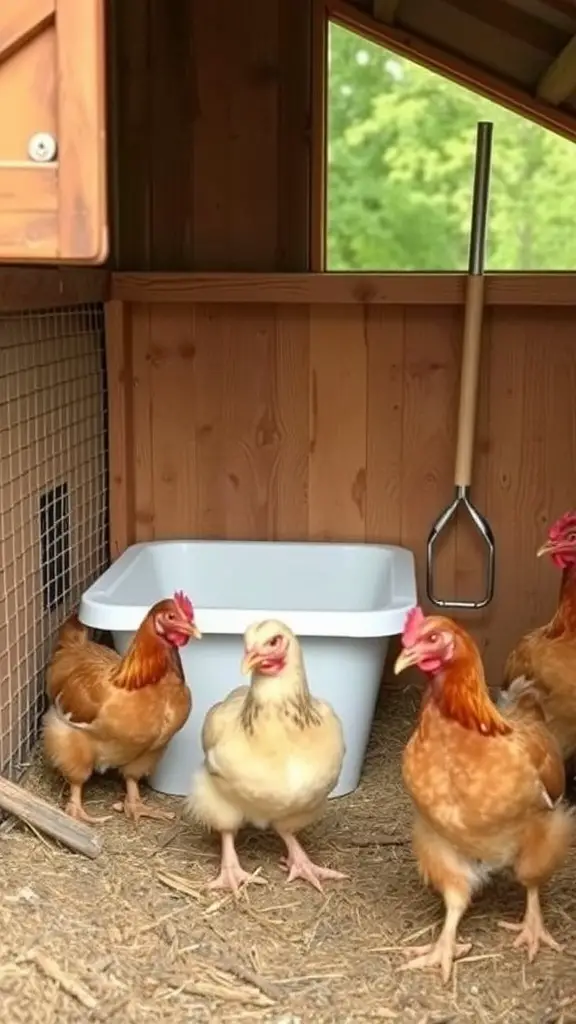
A crucial element when constructing a chicken coop in 2025 is a well-designed cleanout system. This greatly simplifies maintaining a hygienic space for your chickens. The image showcases a straightforward and efficient cleanout solution. A white container serves as a receptacle for used bedding and droppings, promoting cleanliness and ease of management.
Providing a specific waste area is a great idea. The chickens can roam freely, keeping their living space tidy. Regular waste removal reduces smells and creates a healthier environment for your chickens.
The image also features a convenient scoop. It hangs close by for easy access. This tool simplifies waste collection and speeds up cleaning. Proper tools and a well-planned setup minimize cleaning time. This allows you to dedicate more time to enjoying your chickens in 2025.
Decorating the Coop for Style
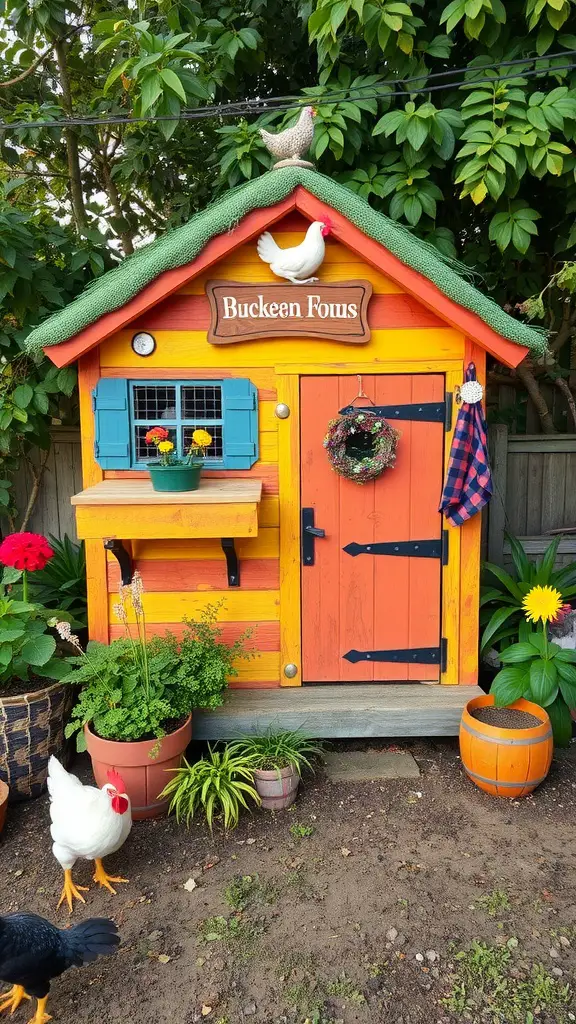
In 2025, chicken coop design balances aesthetics and practicality. The coop in the picture exemplifies this with its lively colors and delightful accents, fostering an inviting space. Its sunny yellow and vibrant orange paint scheme is visually appealing and injects a joyful ambiance into any backyard setting.
Adding decorative touches, like the “Buckeen Rous” sign, personalizes your coop. This small detail showcases the joy of chicken keeping and makes the space uniquely yours. Naming your coop is a fun way to express your personality and add character to your backyard.
Adding plants and flowers elevates your chicken coop’s look. Potted arrangements beautify the area and create a natural habitat for your hens. Think about planting petunias or other vibrant flowers that flourish locally. This adds color and can attract helpful insects, improving the coop’s ecosystem.
Remember to include functional decorations! A door wreath perfectly blends style and practicality. It’s an easy way to create a welcoming coop atmosphere, ensuring your chickens feel at home. A comfortable and inviting coop can lead to healthier, happier chickens.
Lastly, think about adding fun details, such as rooster decorations on the roof. These whimsical touches showcase your passion for chickens and boost the coop’s charm. With some imaginative ideas, you can turn a simple chicken coop into a charming haven that both you and your flock will adore.
Monitoring Chicken Health and Behavior
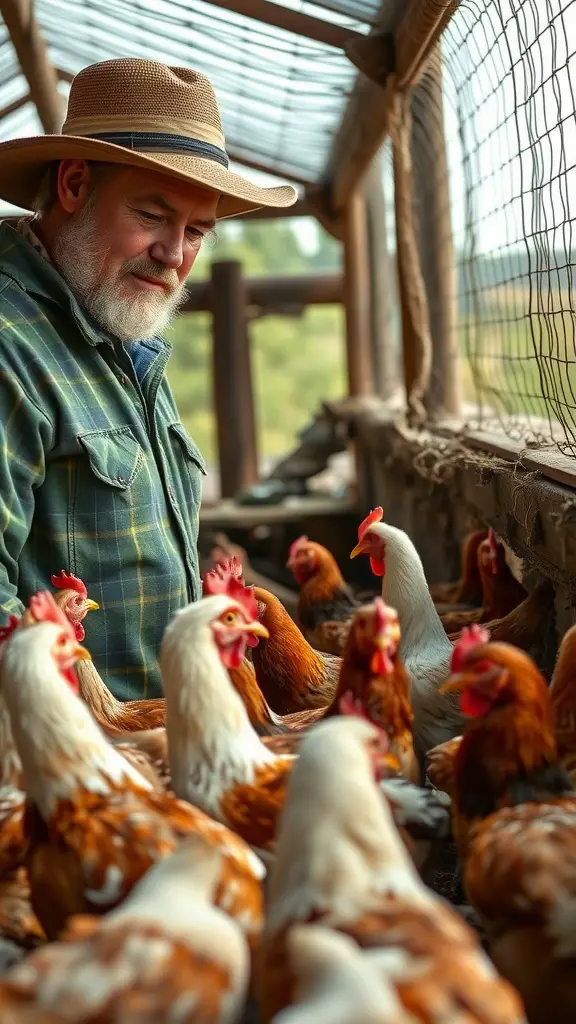
Monitoring your chickens is vital for their health. The picture displays a caretaker carefully watching his chickens. This close observation helps in detecting potential health problems quickly.
Chickens use body language to express emotions. A chicken isolating itself might be sick. Regularly monitor your flock for signs like low energy or altered appetite. This helps ensure a healthy coop.
Spending time with your chickens lets you learn about their individual personalities. Each bird has unique traits. Noticing these quirks helps you spot changes in behavior. These changes might signal stress or illness.
Boost your flock’s well-being with easy monitoring methods. Track their behavior and health in a journal for long-term insights. Ensure your chickens flourish, not just lay eggs, in their coop. This proactive approach helps maintain a healthy and productive flock.
Building a Chicken Coop on a Budget
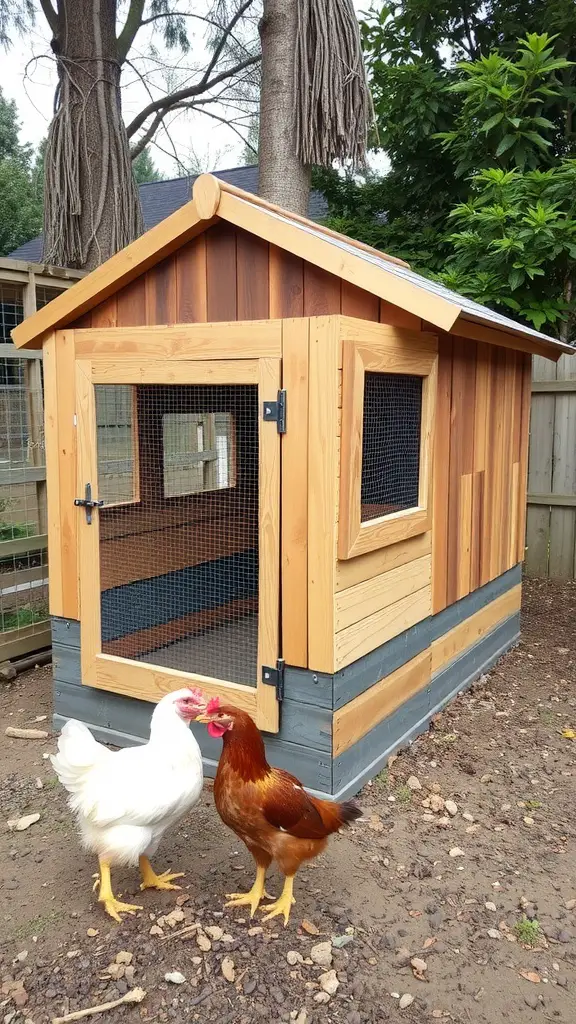
Building a chicken coop doesn’t require a fortune. This picture highlights a comfortable chicken coop. It’s constructed from budget-friendly and practical materials.
This design boasts a delightful wooden exterior. It includes a sloped roof and secure mesh windows. These features enhance the aesthetic appeal and ensure the safety of your birds. Using recycled wood or pallets can dramatically reduce building expenses.
Up front, two chickens seem content in their surroundings. This shows how a good coop boosts their well-being. Forget elaborate designs; practical features create a happy home for your flock.
Explore local suppliers and repurposed items for cost-effective solutions. Check out nearby hardware stores or community marketplaces for unique finds. With a bit of imagination and effort, you can construct a functional and budget-friendly chicken coop.
Choosing the Right Chicken Breeds for Your Coop
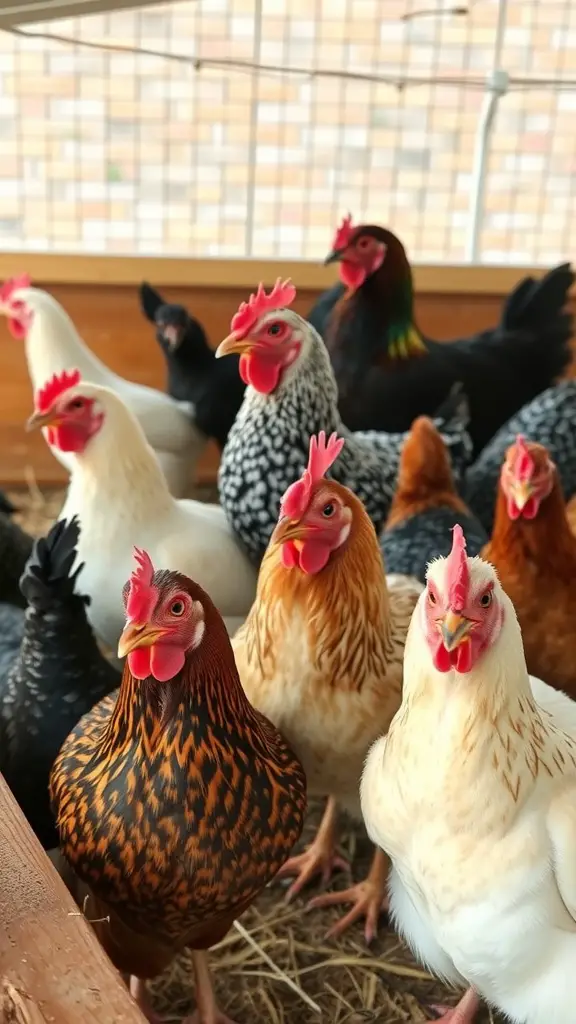
Choosing the right chickens for your backyard coop requires careful consideration. What are your goals? Are you primarily interested in egg production, meat, or simply enjoying the company of these feathered friends? Different chicken breeds possess unique characteristics that can guide your selection process in 2025.
This image showcases a diverse array of chickens. Their striking feather patterns and vibrant colors make them both practical and visually appealing. The Rhode Island Red breed is celebrated for its exceptional egg-laying capabilities. Conversely, Orpingtons are known for their gentle nature and suitability as family pets, especially around children.
Think about your local climate. Certain chicken breeds excel in cold conditions. Others are ideal for warmer areas. Leghorns, for instance, flourish in hot weather. This makes them a great option for warmer regions.
Consider space when planning your coop. Determine how many chickens it can comfortably house. A compact coop suits a few Bantam chickens well. These smaller breeds need less space. If you have ample room, larger breeds will flourish. They’ll also provide you with a generous supply of eggs.
In conclusion, thoroughly research various chicken breeds. Consider their specific requirements, temperament, and compatibility with your daily life. Selecting the perfect breed ensures your chicken coop becomes a joyful and enriching part of your home in 2025.

